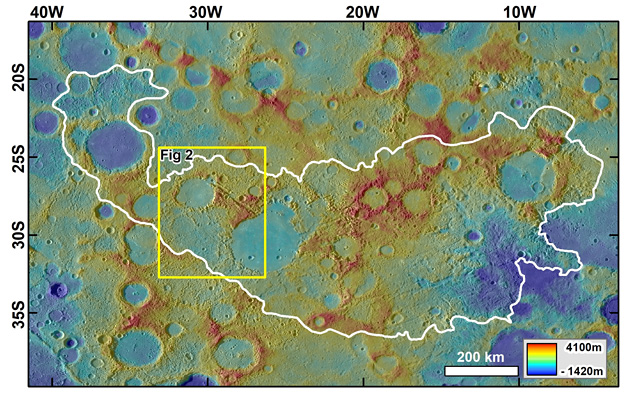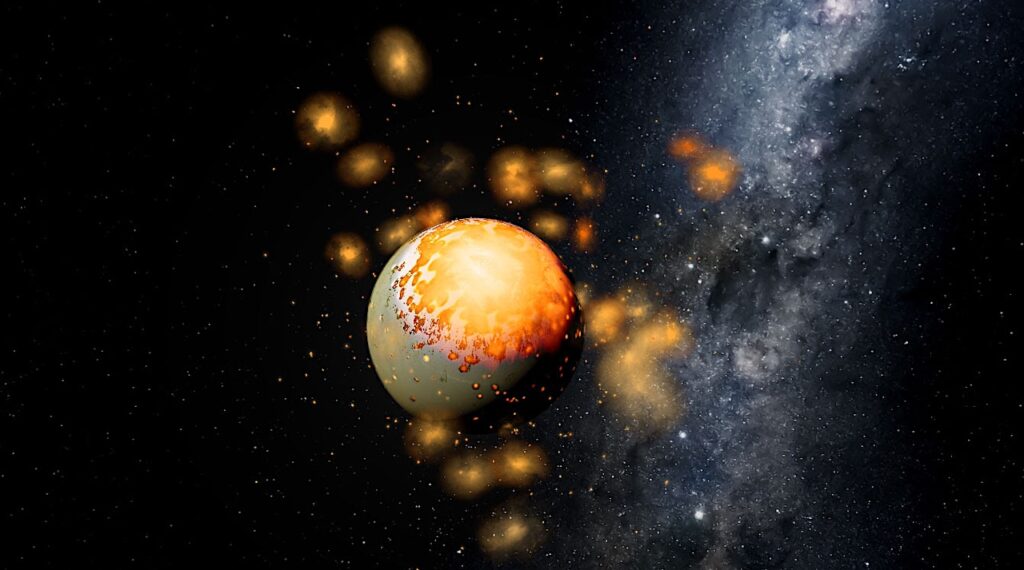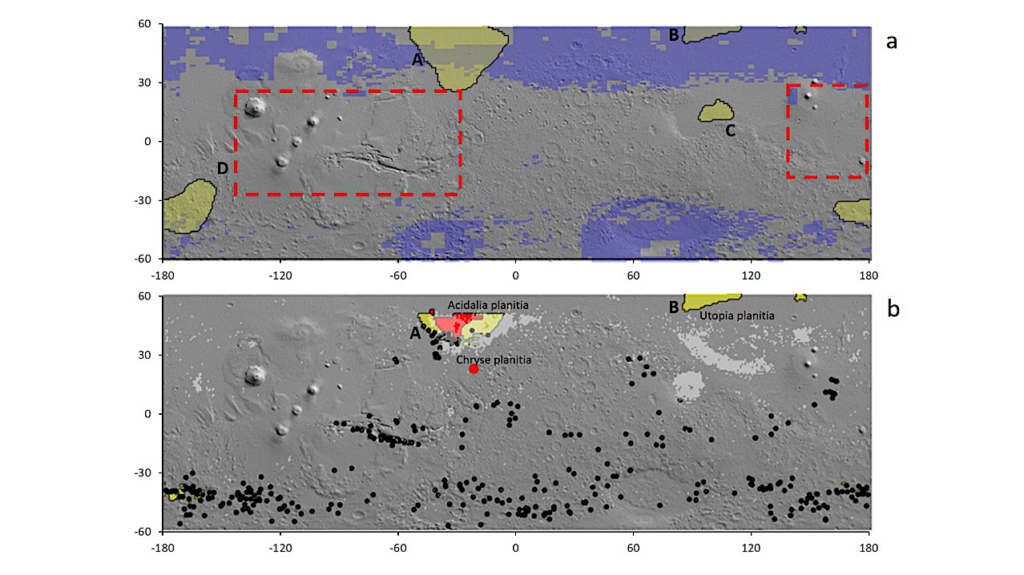Vast Collapsed Terrains on Mercury Might be Windows Into Ancient – Possibly Habitable – Volatile-Rich Materials

New research raises the possibility that some parts of Mercury’s subsurface, and those of similar planets in the galaxy, once could have been capable of fostering prebiotic chemistry, and perhaps even simple life forms, according to a paper by a team led by Planetary Science Institute Research Scientist Alexis Rodriguez.
Chaotic terrains on Mercury opposite the large Caloris impact basin are landscapes produced by the removal of vast volumes of upper crustal volatiles, the paper says.
“The findings mean that Mercury had a thick volatile-rich – possibly but not necessarily water-rich – crust in this location,” said Rodriguez, lead author of “The Chaotic Terrains of Mercury Reveal a History of Planetary Volatile Retention and Loss in the Innermost Solar System” which appears in Nature Scientific Reports (www.nature.com/articles/s41598-020-59885-5). PSI scientists Jeff Kargel, Deborah Domingue, Daniel Berman, Maria Banks, Kevin Webster, and Mark Sykes are coauthors on the paper, written in collaboration with the University of Arizona, NASA Goddard, and the Southwestern Research Institute.
“Mercury’s surface temperature reaches a scorching 430 degrees Celsius during the daytime, and in the absence of an atmosphere, it plummets to -180 degrees Celsius at night. So, its surface environments have rightfully been out of scientific consideration as a possible host of life. However, the paper raises the prospect that some subsurface regions of Mercury have shown capacity for hosting life,” Rodriguez said.
“The deep valleys and enormous mountains that now characterize the chaotic terrains were once part of volatile-rich geologic deposits a few kilometers deep, and do not consist of ancient cratered surfaces that were seismically disturbed due to the formation of Mercury’s Caloris impact basin on the opposite side of the planet, as some scientists had speculated,” said coauthor Berman. “A key to the discovery was the finding that the development of the chaotic terrains persisted until approximately 1.8 billion years ago, 2 billion years after the Caloris basin formed.”
“We identified multi-kilometer surface elevation losses within the chaotic terrains located at the Caloris basin’s antipode. This finding indicates that enormous volumes of crustal volatiles turned into gas and escaped the planet’s upper crust over a surface area slightly larger than that of California, approximately 500,000 square kilometers,” said coauthor Gregory Leonard of the University of Arizona Department of Planetary Sciences.

Fig. 2 Zoom in showing variable magnitudes of collapse, which includes a relatively unmodified rim section that is smooth but not broken into knobs (arrow 1). This area adjoins another part of the rim that has been almost entirely removed (arrow 2). The adjacent intercrater regions also exhibit deep and abrupt relief losses (arrows 3 & 4).
“Our investigation also shows that there are also numerous extensive chaotic terrains in other regions of the planet, which have latitudinal distributions ranging from equatorial to subpolar. Hence, Mercury’s volatile-rich crust appears to be greater than regional, perhaps global, in extent, and it is most likely made up of compositionally diverse volatile compounds. The apparent compositional diversity suggests that the planet’s upper crust might effectively be comprised of a large number of compositional and thermal conditions, some perhaps habitable, existing in Mercury-like exoplanets,” Rodriguez said.
“Vast lava fields formed soon after the development of the chaotic terrains, so volcanic heat could have destabilized and released the apparently vast volumes of crustal volatiles,” said coauthor Webster.
Coauthor Kargel said, “We also observe evidence of surficial devolatilization, probably caused by solar heating. If so, we have an opportunity to infer the range of Mercury’s volatile properties and compositions. A possibility is that Mercury’s volatile-rich crust was delivered via impacts from the frigid confines of the outer Solar System or the main asteroid belt. Alternatively, volatiles were outgassed from the interior.”
“While not all volatiles make for habitability, water ice can if temperatures are right. Some of Mercury’s other volatiles may have added to the characteristics of a former aqueous niche,” Kargel said. Even if habitable conditions existed only briefly, relics of prebiotic chemistry or rudimentary life still might exist in the chaotic terrains.”
“Interestingly, we find that crater ejecta rays, which form some of Mercury’s youngest geologic deposits, appear absent from extensive areas of the chaotic terrain, which we interpret as a possible indication of very recent volatile losses,” said coauthor Domingue.
“Evidence of recent, and perhaps on-going, volatile losses from within near-surface geologic materials on Mercury has been previously documented through the investigation of small depressions known as hollows, which kind of resemble melt pits in terrestrial permafrost,” Rodriguez said. “However, an unresolved issue remains the age disparity between these hollows and their volatile-bearing geologic units, which are thought to be billions of years old. Our results suggest that some hollows might represent the locations where lavas or sublimation lags covering these ancient geologic materials underwent collapse. This is exciting because their distribution might highlight areas where we can effectively access volatile-rich material, that after billions of years existing in the subsurface, have been finally been exposed to the surface.”
Coauthor Sykes said “if these results are confirmed, this and other similar areas of collapse on Mercury could be important considerations for future landing sites to investigate the origin of the planet’s volatile-rich crust and, perhaps, even its astrobiological potential.”
Domingue’s work on this project was supported by a grant to PSI from NASA’s Solar System Working program.

Fig. 3 Context view showing the location and extent of the chaotic terrain antipodal to the Caloris basin (outlined in white) relative to the ray systems of the Kuiper and Debussy impact craters. (B) Close-up view of panel A that provides the context and locations for panels C and D. The numbers 1-9 identify individual rays within the region’s view. (C, D) Close-up view showing crater rays that extend over the chaotic terrain (green lines 6, 8, 9) and other crater rays that appear truncated over the chaotic terrain (red lines 1-5, 7). We provide the location of the hollow hosting crater Dario in panel C.
THE PLANETARY SCIENCE INSTITUTE:
The Planetary Science Institute is a private, nonprofit 501(c)(3) corporation dedicated to Solar System exploration. It is headquartered in Tucson, Arizona, where it was founded in 1972.
PSI scientists are involved in numerous NASA and international missions, the study of Mars and other planets, the Moon, asteroids, comets, interplanetary dust, impact physics, the origin of the Solar System, extra-solar planet formation, dynamics, the rise of life, and other areas of research. They conduct fieldwork on all continents around the world. They also are actively involved in science education and public outreach through school programs, children’s books, popular science books and art.
PSI scientists are based in 30 states and the District of Columbia, and work from various locations around the world.








